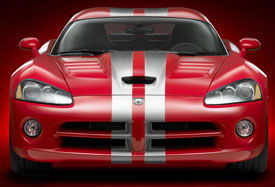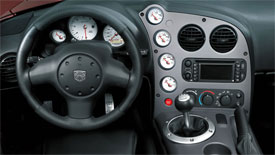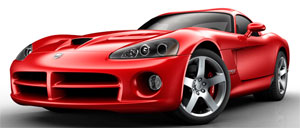2010 Dodge Viper
It was 1991 when we gave you our first driving impressions of the Dodge Viper sports car. It was a promising snake in the grass, as Carroll Shelby’s dream of a modern answer to his ‘60s Cobra was at last realized. Since then, we’ve sampled every Viper’s venom to come down the line. But now, the end of the current Viper SRT10 is near. And before it slithers away, we had to get bitten one more time.
In terms of raw, unadulterated power, there may be no other like the Dodge Viper SRT10. So when it was time to head down to our winter stomping grounds at Georgia’s Roebling Road Raceway, there was no way we were going without taking this salacious serpent with us once last time. Indeed, 2010 is the last model year for the current Dodge Viper Coupe and Roadster, although Chrysler isn’t shutting the door on a future design. Though our test droptop was legally a 2009, the only changes for 2010 are wider racing stripes and a revised 5th gear.
Power comes on from a very familiar and very entertaining 8.4-liter pushrod V10 doling out a monstrous 600 horsepower and 560 pound-feet of torque. Output is sledge-hammered through a heavy duty Tremec six-speed manual gearbox and a speed sensing limited slip differential before hitting the rear wheels.
 Roebling Road’s long front straight is ideal for this snake’s rapid getaway. Our Viper struck 60 in just 3.7 seconds and swallowed the quarter mile in 12 seconds flat at 126 miles per hour. In typical Viper fashion, this car puts down gobs of torque. So much so, that even the massive 19-inch 345-rear tires had to fight to hold the asphalt. But all the smoke and squeal was just what our senses ordered.
Roebling Road’s long front straight is ideal for this snake’s rapid getaway. Our Viper struck 60 in just 3.7 seconds and swallowed the quarter mile in 12 seconds flat at 126 miles per hour. In typical Viper fashion, this car puts down gobs of torque. So much so, that even the massive 19-inch 345-rear tires had to fight to hold the asphalt. But all the smoke and squeal was just what our senses ordered.
Once you do connect, the Viper has a brutal feel all the way down the line. Expect no peaks and valleys. Shifter throws are solid and nicely mechanical, and the heavy, twin-disc clutch delivers great feedback.
Armed with a lightweight double A-arm suspension and coil-over shocks, our snake eagerly hit the tight turns of Roebling Road. Like all Vipers before, it can be a handful. You have to stay completely on top of your game. Especially since there are no electronic helping hands to reel you in.
The Viper stays almost flat in the corners with just enough roll to give you a sense of how hard you’re pushing the envelope. The front-end, however, is very far away from the driver. It’s sometimes hard to get a clear feel of what’s happening up there.
Still, we were able to maintain very high speeds, using the big throttle to power out of corners. The Viper equates itself well, as long as the driver is constantly aware of its limits. Though it doesn’t have the balance or finesse of a Corvette or a Porsche, it is very effective in a blunt force trauma kind of way.
But compared to earlier Vipers, this one is definitely not as crude. Which means it is both more manageable and more exhilarating at speed. But disrespect this car and it will bite you back in a most venomous way. The Viper’s big 14-inch brake discs and Brembo calipers are confidence-inspiring. They allowed us to dive deep into corners knowing that this car could quickly scrub off its overabundance of speed.
Straight-line halts from 60 to 0 averaged 120 feet. Though that’s a fine street number, the brakes worked even more beautifully on the track. They held strong all day long with little to no fade.
In terms of outer show, the Dodge Viper’s silhouette – in coupe and roadster – is unmistakable. From its long hood's air intake and heat extractors to its dual side exhausts, everything about this car hisses predator. For 2010, the Viper offers two new exterior colors: Bright Silver and this Toxic Orange.
 The Viper touts a familiar race inspired cockpit that's simple and tight. Just climb over the tall rocker panels, slide into the form hugging sport seats, and get ready to hold on for dear life. For that, the beefy leather-wrapped tilt steering wheel is perfect.
The Viper touts a familiar race inspired cockpit that's simple and tight. Just climb over the tall rocker panels, slide into the form hugging sport seats, and get ready to hold on for dear life. For that, the beefy leather-wrapped tilt steering wheel is perfect.
While you're waiting your turn, turn up the seven-speaker 310-watt stereo. But, on the track, the car itself provides all the hardcore driving sounds you need.
While we doubt it's a concern for owners, Government Fuel Economy ratings are 13 city/22 highway on premium gas. Low, but better than some exotics that are neither as fast nor as affordable. That said, still expect to plunk down at least $92,000 for one of the last Vipers. And, yes, that does include Uncle Sam's $1,700 gas guzzler tax.
While the Dodge Viper's future under Fiat management is uncertain, after nearly two decades of road-grinding, tire-melting action, this American reptile continues to thrill as one of the premiere performance machines of all-time. For this car's venom, thankfully, there is no antidote.Specifications
- Engine: 8.4-Liter Pushrod V10
- Horsepower: 600
- Torque: 560 Lb Feet
- 0-60 MPH: 3.7 Seconds
- 1/4 Mile: 12.0 Seconds @ 126 MPH
- 60-0 MPH: 120 Feet
- EPA: 13 MPG City/ 22 MPG Highway






